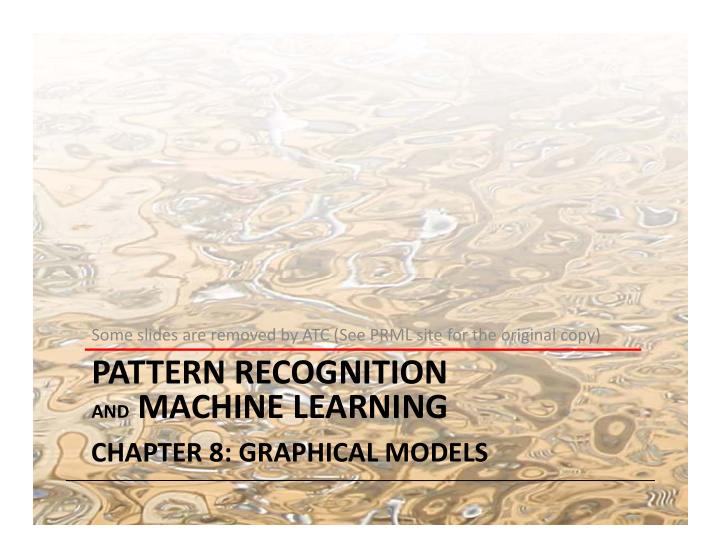



Some slides are removed by ATC (See PRML site for the original copy) PATTERN RECOGNITION AND MACHINE LEARNING CHAPTER 8: GRAPHICAL MODELS
Bayesian Networks Directed Acyclic Graph (DAG)
Bayesian Networks General Factorization
Generative Models Causal process for generating images
Discrete Variables (1) General joint distribution: �� �� ��� parameters Independent joint distribution: �� � ���� parameters
Discrete Variables (2) General joint distribution over � variables: � � ��� parameters �� -node Markov chain: � ������� � ���� � � � ���� �� -node Markov chain: � ������� � ���� � � � ���� parameters
Conditional Independence � is independent of � given � Equivalently Equivalently Notation
Conditional Independence: Example 1
Conditional Independence: Example 1
Conditional Independence: Example 2
Conditional Independence: Example 2
Conditional Independence: Example 3 Note: this is the opposite of Example 1, with � unobserved.
Conditional Independence: Example 3 Note: this is the opposite of Example 1, with � observed.
“Am I out of fuel?” � = Battery (0=flat, 1=fully charged) � = Fuel Tank (0=empty, 1=full) and hence � = Fuel Gauge Reading (0=empty, 1=full)
“Am I out of fuel?” Probability of an empty tank increased by observing �� ��� .
“Am I out of fuel?” Probability of an empty tank reduced by observing �� ��� . This referred to as “explaining away”.
D-separation � � , � , and � are non-intersecting subsets of nodes in a directed graph. � A path from � to � is blocked if it contains a node such that either a) the arrows on the path meet either head-to-tail or tail- to-tail at the node, and the node is in the set � , or to-tail at the node, and the node is in the set � , or b) the arrows meet head-to-head at the node, and neither the node, nor any of its descendants, are in the set � . � If all paths from � to � are blocked, � is said to be d- separated from � by � . � If � is d-separated from � by � , the joint distribution over all variables in the graph satisfies .
D-separation: Example
D-separation: I.I.D. Data
The Markov Blanket Factors independent of � � cancel between numerator and denominator.
Markov Random Fields Markov Blanket
Cliques and Maximal Cliques Clique Maximal Clique
Joint Distribution where is the potential over clique � and is the normalization coefficient; note: � � -state variables → � � terms in � . Energies and the Boltzmann distribution
Illustration: Image De-Noising (1) Original Image Noisy Image
Illustration: Image De-Noising (2)
Illustration: Image De-Noising (3) Noisy Image Restored Image (ICM)
Illustration: Image De-Noising (4) Restored Image (ICM) Restored Image (Graph cuts)
Converting Directed to Undirected Graphs (1)
Converting Directed to Undirected Graphs (2) Additional links
Directed vs. Undirected Graphs (1)
Directed vs. Undirected Graphs (2)
Factor Graphs
Factor Graphs from Directed Graphs
Factor Graphs from Undirected Graphs
Recommend
More recommend